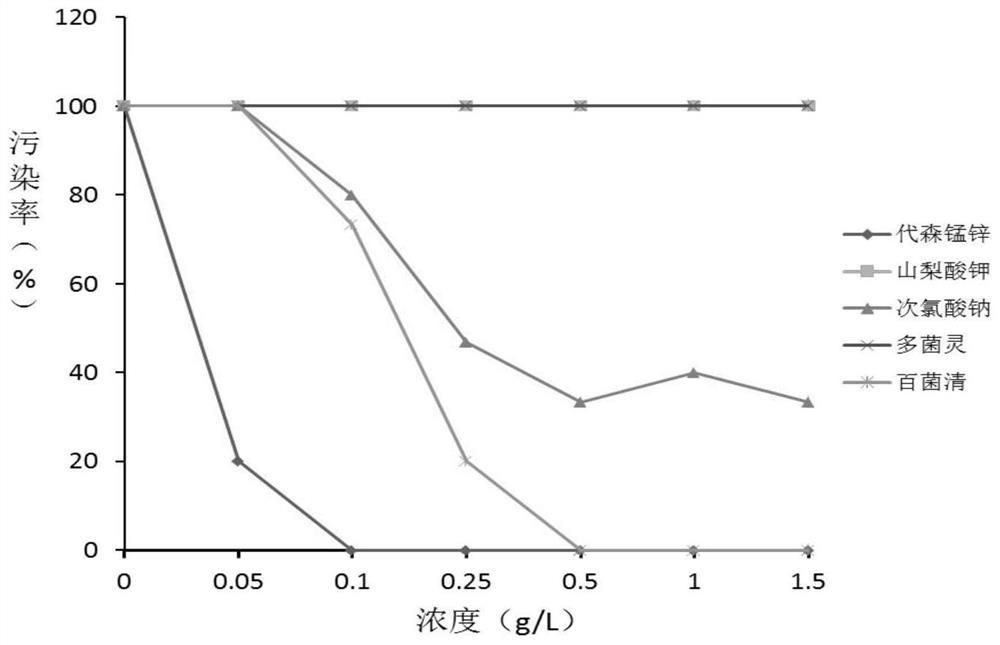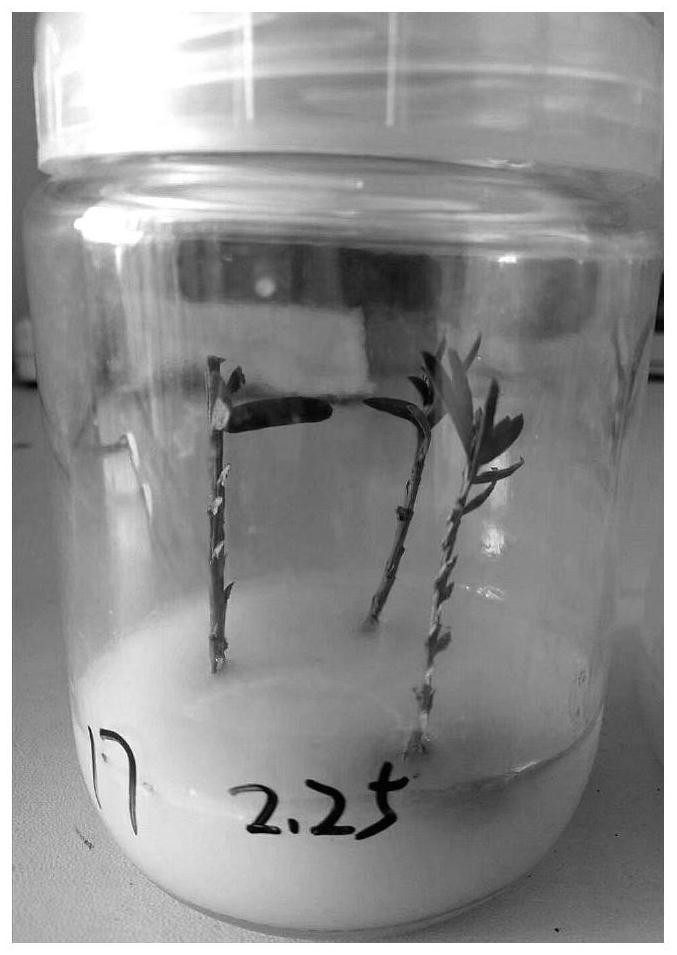Method for improving rooting rate of taxus media tissue culture seedlings
A technology of Taxus chinensis and tissue culture seedlings, which is applied in the field of plant propagation, can solve the problems of limited test materials, limited popularization and application, and unsuitability for industrialized seedling cultivation, so as to save space and materials, and has broad application prospects. Prominent growth-promoting effect
- Summary
- Abstract
- Description
- Claims
- Application Information
AI Technical Summary
Problems solved by technology
Method used
Image
Examples
Embodiment 1
[0056] Embodiment 1 Open tissue culture antibacterial condition research
[0057] 1. Natural drop test
[0058] Prepare media in an open environment without autoclaving:
[0059]Add 8g / L agar to sugar-free 1 / 2MS liquid medium (Table 1), boil until transparent, adjust pH to 5.8-6.0, add bacteriostat after cooling down to about 50°C, fully stir the medium, and quantitatively distribute Put it into a clean tissue culture bottle, expose it to the air for 1 hour, seal it and place it in an incubator at 25°C for cultivation.
[0060] Bacteriostatic agents are: sodium hypochlorite solution, 70% dysonium wettable powder, 50% carbendazim wettable powder, potassium sorbate and 75% chlorothalonil wettable powder; each bacteriostatic agent is set at 0.05, 0.1 , 0.25, 0.5, 1.0, 1.5g / L6 concentrations, plus blank control (CK) for a total of 31 treatments, each treatment set 5 samples, repeated 3 times, according to the pollution situation, judge the antibacterial effect, if there is antib...
Embodiment 2
[0083] The screening of embodiment 2 culture medium agar concentration
[0084] Add agar powder (2.5, 3, 3.5, 4, 4.5, 5, 5.5, 6g / L, 7 concentrations in total) into the sugar-free 1 / 2MS medium liquid, stir evenly with a glass rod, gradually cook until transparent, adjust When the pH is 5.8-6.0, without high temperature and high pressure sterilization, the boiled culture medium of each concentration is divided into two parts, one part is added with 0.08g / L mancozeb, the other part is not added with antibacterial agent, and then poured into In a clean tissue culture bottle, five replicate samples were processed for each treatment, cooled for 2 hours, and the solidification state and hardness of the medium were observed and recorded.
[0085] The result is as shown in table 5, when the agar concentration is at 2.5-3g / L, the medium will have flow and sticky wall phenomenon, can not play the effect of supporting the explant; When the concentration is at 5-6g / L, the medium is hard, ...
Embodiment 3
[0088] Embodiment 3 tissue culture rooting experiment
[0089] Prepare media in an open environment without autoclaving:
[0090] Add 4g / L agar to the sugar-free 1 / 2MS liquid medium, boil until transparent, adjust the pH to 5.8-6.0, cool down to about 50°C, add 0.08g / L mancozeb, fully stir the medium, and quantify Pack into tissue culture bottles, seal and set aside.
[0091] Take 1-2 year-old robust branches of Taxus chinensis, brush off the dust on the surface with a soft brush, cut off 3-5cm long stems with axillary buds, and remove 1 / 3-1 / 2 needles on the stems from the base , as explants.
[0092] Put the explants into a beaker, drop a few drops of detergent, stir and soak for 10 minutes, rinse with running water for 1 hour; then completely soak in alcohol with a mass fraction of 75% for 30 seconds, rinse with sterile water for 5 times; then completely soak in mass fraction Sterilize in 0.1% mercuric chloride for 10 minutes, then rinse with sterile water 8 times. After...
PUM
 Login to View More
Login to View More Abstract
Description
Claims
Application Information
 Login to View More
Login to View More - R&D Engineer
- R&D Manager
- IP Professional
- Industry Leading Data Capabilities
- Powerful AI technology
- Patent DNA Extraction
Browse by: Latest US Patents, China's latest patents, Technical Efficacy Thesaurus, Application Domain, Technology Topic, Popular Technical Reports.
© 2024 PatSnap. All rights reserved.Legal|Privacy policy|Modern Slavery Act Transparency Statement|Sitemap|About US| Contact US: help@patsnap.com










